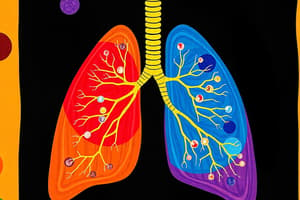Podcast
Questions and Answers
What are the tiny air sacs at the end of each bronchiole called?
What are the tiny air sacs at the end of each bronchiole called?
- Alveoli (correct)
- Bronchi
- Thorax
- Pleura
What is the name of the structure that houses the bronchial tree, lungs, and heart?
What is the name of the structure that houses the bronchial tree, lungs, and heart?
- Thorax (correct)
- Alveoli
- Pleura
- Diaphragm
What type of tissue do lungs contain that allows them to inflate and deflate easily?
What type of tissue do lungs contain that allows them to inflate and deflate easily?
- Inelastic
- Rigid
- Hardened
- Elastic (correct)
What is the thin lining that covers the lungs called?
What is the thin lining that covers the lungs called?
What is the network of alveoli, bronchioles, and bronchi known as?
What is the network of alveoli, bronchioles, and bronchi known as?
Flashcards
Bronchioles
Bronchioles
Small tubes branching from the bronchi, leading to alveoli.
Alveoli
Alveoli
Tiny air sacs at the end of bronchioles where oxygen and carbon dioxide exchange occurs.
Bronchial Tree
Bronchial Tree
The network of bronchi, bronchioles, and alveoli in the lungs.
Thorax
Thorax
Signup and view all the flashcards
Pleura
Pleura
Signup and view all the flashcards
Study Notes
- The bronchi divide into smaller bronchi, then into even smaller tubes called bronchioles.
- At the end of each bronchiole are tiny air sacs called alveoli, where oxygen and carbon dioxide exchange occurs.
- Each person has hundreds of millions of alveoli in their lungs.
- The network of alveoli, bronchioles, and bronchi is known as the bronchial tree.
- The lungs contain elastic tissue, which allows them to inflate and deflate easily.
- Lungs have a thin lining called the pleura.
- The thorax is the airtight box that houses the bronchial tree, lungs, heart, and other structures.
- The top and sides of the thorax are formed by the ribs and muscles.
- Chest walls form a protective cage around the organs in the chest cavity.
- The bottom of the chest cavity is formed by the diaphragm.
Studying That Suits You
Use AI to generate personalized quizzes and flashcards to suit your learning preferences.




